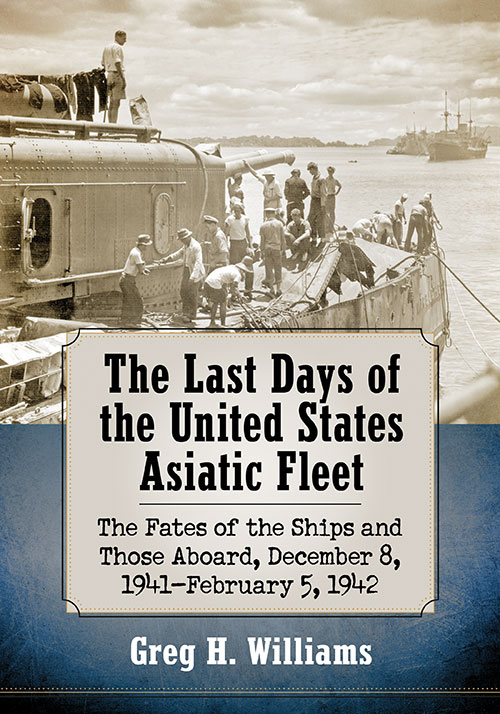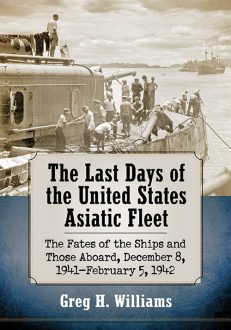The Last Days of the United States Asiatic Fleet
The Fates of the Ships and Those Aboard, December 8, 1941–February 5, 1942
$49.95
In stock
About the Book
After the attack on Pearl Harbor (December 7), American sailors of the Asiatic Fleet (where it was December 8) were abandoned by Washington and left to conduct a war on their own, isolated from the rest of the U.S. naval forces. Their fate in the Philippines and Dutch East Indies was often grim—many died aboard burning ships, were executed upon capture or spent years as prisoners of war.
Many books have been written about the ships of the U.S. Asiatic Fleet, yet few look into the experiences of the common sailor. Drawing on official reports, past research, personal memoirs and the writings of war correspondents, the author tells the story of those who never came home in 1945.
About the Author(s)
Bibliographic Details
Greg H. Williams
Format: softcover (7 x 10)
Pages: 429
Bibliographic Info: 13 photos, bibliography, index
Copyright Date: 2018
pISBN: 978-1-4766-7248-9
eISBN: 978-1-4766-3167-7
Imprint: McFarland
Book Reviews & Awards
Preface 1
Introduction 3
I. The U.S. Navy in the Pacific 7
Planting the Flag 8
The Philippines 9
China 11
II. Setting the Stage for War 14
The Naval Disarmament Conference 14
Petroleum 16
Borneo 17
Manchuria 19
III. Japan on the Move 21
The Response 21
“Asia for the Asians” 23
American Missions and the Panay 24
Uncertainty at Home 27
A New Commander in the Far East 29
The Fleet Moves to Pearl Harbor 31
French Indo-China 31
Admiral Hart Relocates 32
Plans Evolve 33
Americans Evacuate 34
IV. Fateful Decisions 36
V. The Asiatic Fleet on the Eve of War 42
The Cruisers 42
The Destroyers 42
The Yangtze Patrol 44
The Submarines 45
The Air Patrol Wing 46
The Minesweepers 47
The Motor Torpedo Boats 48
The 16th Naval District 48
Cavite Navy Yard 49
Olongapo Naval Station 50
Mariveles Section Base 51
VI. Preparations for War 52
A Visit to Pearl Harbor 52
Army Bombers Go East, the Marines Go South 53
Admiral Hart’s Proposal 53
Army vs. Navy 55
Fleet Reorganization 57
The War Warning 58
Columbus Smith at Shanghai 59
Major Ship Movements Detected 60
The Boise Shanghaied 61
The Riverboats Go South 62
Preparing for the Worst 62
British Plans 63
VII. Who Knew What? 65
VIII. Japan Attacks 78
The Wake 79
The President Harrison 83
Cavite Ships 84
Army Air Bases Attacked 86
The William B. Preston 86
Early News 87
IX. The Asiatic Fleet at War 92
The Tutuila Trapped 92
Manila Bombings 95
December 10—A Rough Day for the Allies 95
The Invasion Convoy Arrives 96
Capt. Colin Kelly 97
The Prince of Wales and the Repulse 97
Cavite Bombed 99
X. The Retreat Begins 108
The Air Wing Heads South 109
General Ship Movements 109
The Corregidor 110
Ambon Island 112
Admiral Hart Moves South 112
Christmas 1941 113
Mistaken Identity 114
The Canopus 116
XI. The Fleet’s Last Year 118
The Borneo Oil Fields 120
A Trip to Washington 121
A False Alarm 122
Destroyers off Balik Papan 123
The Mariveles Naval Defense Battalion 127
Policy Opinions 149
The Flores Sea 150
A Sub Commander and a Flight on a PBY 159
The Asiatic Fleet Disbanded 162
A Visit with the Troops 163
Admiral Hart Replaced 164
Timor 164
A New Source of Oil 166
Port Darwin 166
Badung Strait 175
Aircraft to Java 179
The Java Sea 210
Sunda Strait 215
The Stewart Captured 274
Ships Ordered to Australia 274
XII. Stranded Up North 294
Token Relief 294
The Abandoned 295
The Surrender and the Quail 305
XIII. Individual Group Operations 317
The PT Boats 317
The Submarine Patrols 332
Patrol Wing 10 Operations 362
XIV. The Disposition of Asiatic Fleet Ships 389
XV. Irish Pennants 397
A Tale of Two Quail Survivors 397
The Arisan Maru 400
Joseph Henry Bangust 401
The Houston Survivors 402
Charley Lawrence Thomas 403
A Few Commanders 403
Those Adrift 407
The End at the Beginning 408
Navy Items of Interest 409
Civil Authorities 409
Ratings 409
Fast Forward 411
Bibliography 413
Index 415





